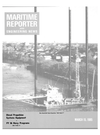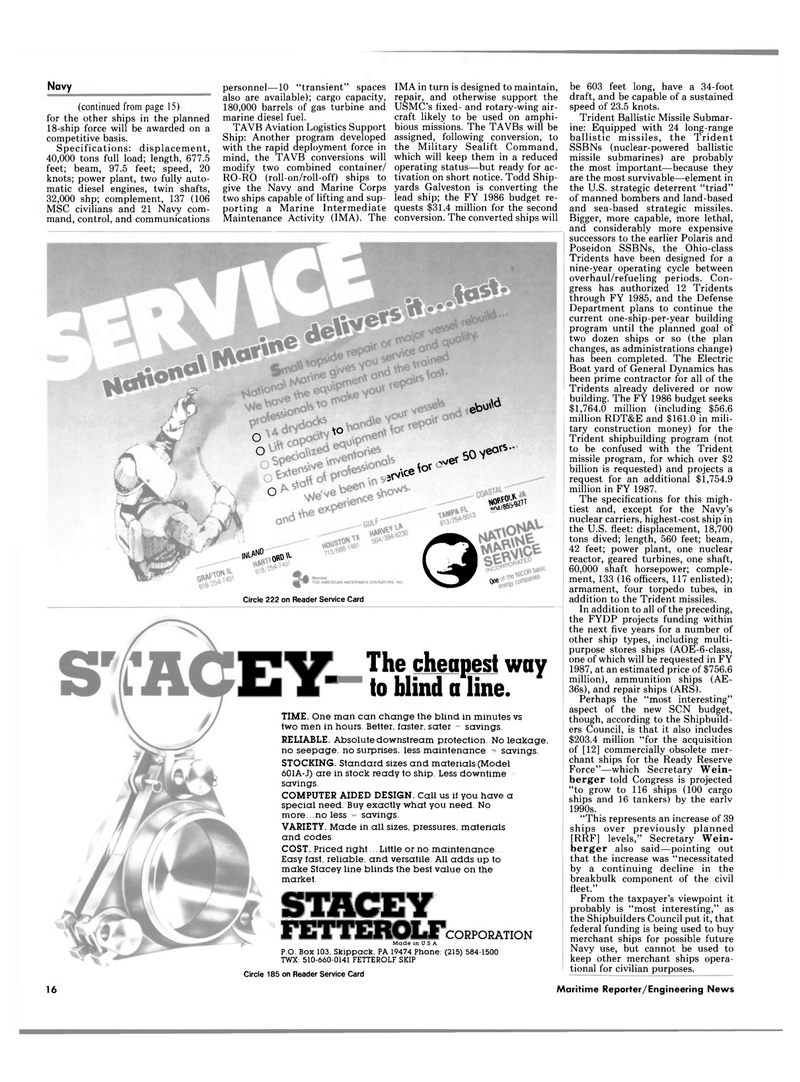
Page 14: of Maritime Reporter Magazine (March 15, 1985)
Read this page in Pdf, Flash or Html5 edition of March 15, 1985 Maritime Reporter Magazine
Navy (continued from page 15) for the other ships in the planned 18-ship force will be awarded on a competitive basis.
Specifications: displacement, 40,000 tons full load; length, 677.5 feet; beam, 97.5 feet; speed, 20 knots; power plant, two fully auto- matic diesel engines, twin shafts, 32,000 shp; complement, 137 (106
MSC civilians and 21 Navy com- mand, control, and communications personnel—10 "transient" spaces also are available); cargo capacity, 180,000 barrels of gas turbine and marine diesel fuel.
TAVB Aviation Logistics Support
Ship: Another program developed with the rapid deployment force in mind, the TAVB conversions will modify two combined container/
RO-RO (roll-on/roll-off) ships to give the Navy and Marine Corps two ships capable of lifting and sup- porting a Marine Intermediate
Maintenance Activity (IMA). The
IMA in turn is designed to maintain, repair, and otherwise support the
USMC's fixed- and rotary-wing air- craft likely to be used on amphi- bious missions. The TAVBs will be assigned, following conversion, to the Military Sealift Command, which will keep them in a reduced operating status—but ready for ac- tivation on short notice. Todd Ship- yards Galveston is converting the lead ship; the FY 1986 budget re- quests $31.4 million for the second conversion. The converted ships will o o \o ebv>\' ad 3Vv\ce
O to* we* 50 V eo^- iNLA^o^W. ass*1
Q 0(« be 603 feet long, have a 34-foot draft, and be capable of a sustained speed of 23.5 knots.
Trident Ballistic Missile Submar- ine: Equipped with 24 long-range ballistic missiles, the Trident
SSBNs (nuclear-powered ballistic missile submarines) are probably the most important—because they are the most survivable—element in the U.S. strategic deterrent "triad" of manned bombers and land-based and sea-based strategic missiles.
Bigger, more capable, more lethal, and considerably more expensive successors to the earlier Polaris and
Poseidon SSBNs, the Ohio-class
Tridents have been designed for a nine-year operating cycle between overhaul/refueling periods. Con- gress has authorized 12 Tridents through FY 1985, and the Defense
Department plans to continue the current one-ship-per-year building program until the planned goal of two dozen ships or so (the plan changes, as administrations change) has been completed. The Electric
Boat yard of General Dynamics has been prime contractor for all of the
Tridents already delivered or now building. The FY 1986 budget seeks $1,764.0 million (including $56.6 million RDT&E and $161.0 in mili- tary construction money) for the
Trident shipbuilding program (not to be confused with the Trident missile program, for which over $2 billion is requested) and projects a request for an additional $1,754.9 million in FY 1987.
The specifications for this migh- tiest and, except for the Navy's nuclear carriers, highest-cost ship in the U.S. fleet: displacement, 18,700 tons dived; length, 560 feet; beam, 42 feet; power plant, one nuclear reactor, geared turbines, one shaft, 60,000 shaft horsepower; comple- ment, 133 (16 officers, 117 enlisted); armament, four torpedo tubes, in addition to the Trident missiles.
In addition to all of the preceding, the FYDP projects funding within the next five years for a number of other ship types, including multi- purpose stores ships (AOE-6-class, one of which will be requested in FY 1987, at an estimated price of $756.6 million), ammunition ships (AE- 36s), and repair ships (ARS).
Perhaps the "most interesting" aspect of the new SCN budget, though, according to the Shipbuild- ers Council, is that it also includes $203.4 million "for the acquisition of [12] commercially obsolete mer- chant ships for the Ready Reserve
Force"—which Secretary Wein- berger told Congress is projected "to grow to 116 ships (100 cargo ships and 16 tankers) by the earlv 1990s. "This represents an increase of 39 ships over previously planned [RRF] levels," Secretary Wein- berger also said—pointing out that the increase was "necessitated by a continuing decline in the breakbulk component of the civil fleet."
From the taxpayer's viewpoint it probably is "most interesting," as the Shipbuilders Council put it, that federal funding is being used to buy merchant ships for possible future
Navy use, but cannot be used to keep other merchant ships opera- tional for civilian purposes.
Circle 222 on Reader Service Card
EY- The cheapest way to blind a line.
TIME. One man can change the blind in minutes vs two men in hours. Better, taster, sater - savings.
RELIABLE. Absolute downstream protection. No leakage, no seepage, no surprises, less maintenance savings.
STOCKING. Standard sizes and materials (Model 601A-J) are in stock ready to ship. Less downtime savings.
COMPUTER AIDED DESIGN. Call us if you have a special need Buy exactly what you need No more ...no less savings.
VARIETY. Made in all sizes, pressures, materials and codes.
COST. Priced right. . Little or no maintenance
Easy last, reliable, and versatile. All adds up to make Stacey line blinds the best value on the market.
STACEY FETTEROLF
CORPORATION
Made in U S A
P.O. Box 103, Skippack, PA 19474 Phone: (215) 584-1500
TWX: 510-660-0141 FETTEROLF SKIP
Circle 185 on Reader Service Card 16 Maritime Reporter/Engineering News

 13
13

 15
15
